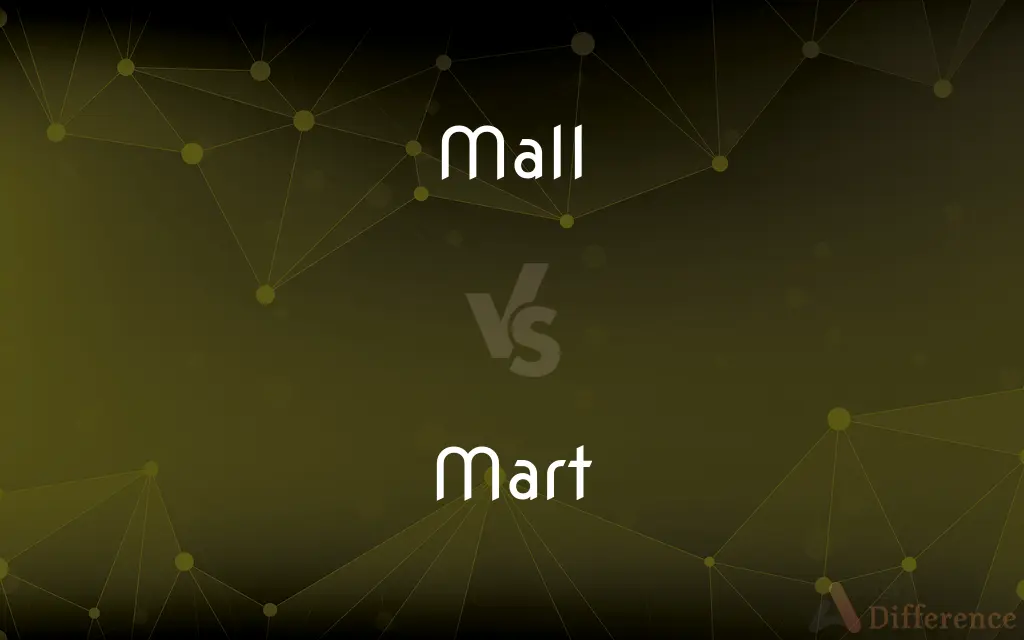Mall vs. Mart — What's the Difference?
By Tayyaba Rehman & Maham Liaqat — Updated on March 2, 2024
A mall is a large indoor shopping complex offering a variety of stores and services, often featuring food courts and entertainment options, whereas a mart is a marketplace or retail store specializing in a specific type of goods or a broader selection.

Difference Between Mall and Mart
Table of Contents
ADVERTISEMENT
Key Differences
Malls are designed as expansive, multi-level buildings housing a wide range of retail stores, from clothing and electronics to home goods and luxury brands. They provide a comprehensive shopping experience, combining retail with leisure activities, including cinemas, arcades, and dining areas, making them popular destinations for both shopping and entertainment. On the other hand, marts focus more on the practical aspects of shopping, offering goods in a specific category, such as furniture, electronics, or groceries, or presenting a wide array of merchandise in a no-frills, utilitarian setting.
Malls often emphasize an aesthetic and comfortable environment, with features such as indoor landscaping, seating areas, and climate control to enhance the shopping experience. Marts are typically single-story, with goods arranged in an accessible manner, prioritizing convenience and efficiency over the shopping experience. They may offer competitive pricing and bulk purchase options, appealing to budget-conscious consumers or those with specific shopping needs.
While malls cater to a broad demographic looking for a variety of products and services in a single location, marts serve customers with specific shopping lists or those seeking bargains. The operational scale and customer experience between malls and marts differ significantly; malls require large spaces and attract customers willing to spend time exploring different stores and amenities, whereas marts are more straightforward, focusing on quick visits and the direct purchase of goods.
The development and management of malls involve significant investment in architecture, tenant mix, and amenities to attract both shoppers and retailers. In contrast, marts require less investment in ambiance, focusing more on the selection and pricing of goods to attract a targeted customer base.
Malls and marts cater to different shopping preferences and needs, with malls offering a diverse and leisure-oriented shopping environment and marts providing a more focused and efficient shopping experience.
ADVERTISEMENT
Comparison Chart
Definition
Large indoor shopping complex
Marketplace or store for specific goods
Environment
Multi-level, aesthetically pleasing
Single-story, utilitarian
Focus
Variety of stores, leisure activities
Specific type of goods, efficiency
Experience
Leisurely shopping, entertainment options
Quick, convenient shopping
Customer
Broad demographic, experience seekers
Budget-conscious, specific needs
Pricing
Varied, from affordable to luxury
Competitive, often with bulk options
Layout
Spacious, with amenities and landscaping
Straightforward, accessible product display
Operational Scale
Large, requires significant investment
Smaller, less emphasis on ambiance
Compare with Definitions
Mall
A large shopping center.
The local mall features over 100 stores, including a cinema and food court.
Mart
A retail outlet specializing in goods.
The furniture mart offers a wide range of home furnishings.
Mall
Climate-controlled environment.
The mall offers a comfortable shopping experience year-round.
Mart
Focuses on specific shopping needs.
Shoppers visit the electronics mart for the latest gadgets.
Mall
Diverse retail options.
From designer boutiques to electronics, the mall caters to all shopping needs.
Mart
Efficient, no-frills shopping.
The grocery mart is known for its quick checkout process.
Mall
Combines retail with leisure.
Families enjoy weekends at the mall for shopping and movies.
Mart
Competitive pricing.
The discount mart offers bulk purchase options at lower prices.
Mall
Leisure and entertainment hub.
The mall's indoor playground and arcade are popular among children.
Mart
A trading center; a market.
Mall
A large, often enclosed shopping complex containing various stores, businesses, and restaurants usually accessible by common passageways.
Mart
A place where goods are sold; a store.
Mall
A street lined with shops and closed to vehicles.
Mart
Straightforward layout.
Products in the mart are easily accessible, making shopping efficient.
Mall
A place where the game of mall was played. Hence: A public walk; a level shaded walk.
Part of the area was laid out in gravel walks, and planted with elms; and these convenient and frequented walks obtained the name of the City Mall.
Mart
A market.
Where has commerce such a mart . . . as London?
Mall
A shopping area with multiple shops and a concourse for predominantly or exclusively pedestrian use; in cities the concourse is usually a city street which may be temporarily or permamently closed to motor vehicles; in suburban areas, a mall is often located on a convenient highway, may be large, contained in one building or in multiple buildings connected by (usually covered) walkways. Also called shopping mall
Mart
To buy or sell in, or as in, a mart.
To sell and mart your officer for goldTo undeservers.
Mart
An area in a town where a public mercantile establishment is set up
Common Curiosities
How do malls and marts differ in layout and design?
Malls feature multi-level, aesthetically pleasing designs with amenities, while marts have a single-story, utilitarian layout focused on product accessibility.
Who typically shops at marts?
Marts attract budget-conscious consumers or those with specific shopping lists looking for efficiency and competitive pricing.
What is a mall?
A mall is an enclosed shopping center with a variety of stores and services, designed for a comprehensive shopping and entertainment experience.
Can you find entertainment options in a mart?
Marts primarily focus on the sale of goods and typically do not offer the leisure and entertainment options found in malls.
What is a mart?
A mart is a retail space focused on selling specific types of goods, often in a straightforward, warehouse-like environment.
How do malls attract customers?
Malls attract customers through a mix of retail options, aesthetic environment, and entertainment facilities, catering to a wide range of preferences and needs.
Are marts less expensive than malls?
Marts often offer competitive pricing and bulk options, potentially providing a more budget-friendly shopping experience compared to the varied pricing in malls.
Why do people spend more time in malls than in marts?
The variety of stores, dining, and entertainment options in malls encourage visitors to spend more time exploring and enjoying the amenities.
What makes marts appealing to shoppers?
The straightforward layout, focus on specific goods, and competitive pricing make marts appealing to shoppers seeking efficiency and value.
Do malls and marts serve the same purpose?
While both serve as retail spaces, malls offer a broad, leisure-oriented shopping experience, whereas marts focus on efficient, targeted shopping.
Share Your Discovery

Previous Comparison
Cone vs. Nappe
Next Comparison
Ballister vs. SolicitorAuthor Spotlight
Written by
Tayyaba RehmanTayyaba Rehman is a distinguished writer, currently serving as a primary contributor to askdifference.com. As a researcher in semantics and etymology, Tayyaba's passion for the complexity of languages and their distinctions has found a perfect home on the platform. Tayyaba delves into the intricacies of language, distinguishing between commonly confused words and phrases, thereby providing clarity for readers worldwide.
Co-written by
Maham Liaqat













































